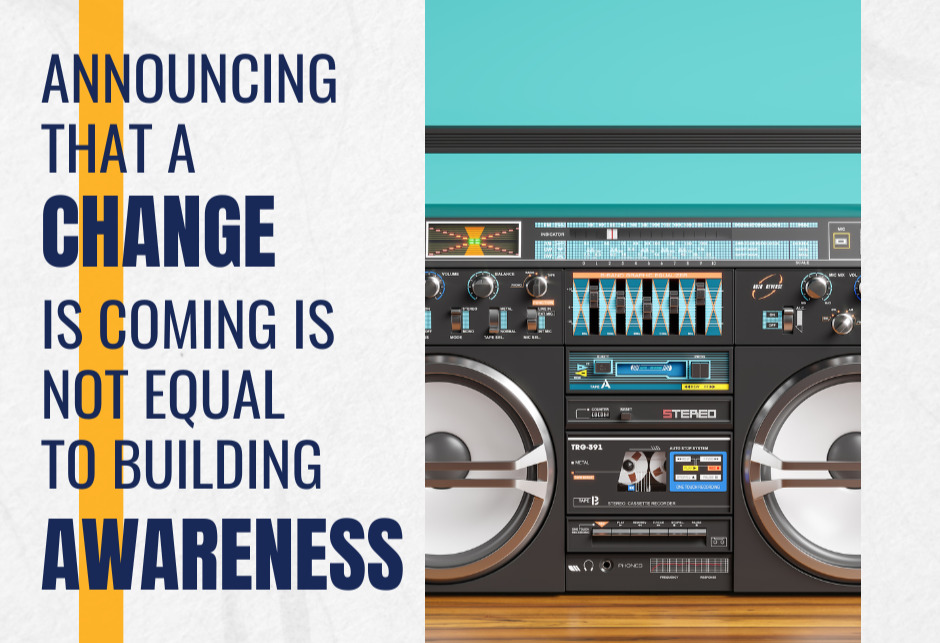You arrive at work to find an invitation to attend an all-company “special meeting” where the CEO will share an important message.
Something is about to change. And it is going to be BIG!
In the hours before the scheduled meeting, the “meetings before the meeting” are in full swing. Speculation and anxiety are high. Work grinds to a halt. People are worried.
And then…the “Big Announcement” happens!
The CEO leaves the stage, breathes a sigh of relief, and gets back to business knowing that she has successfully created awareness of the change (new organizational structure, leadership change, merger, etc.) She is confident that her employees are well informed.
Job well done, right?
Maybe. Or maybe not.
Announcing that a change is coming is not equal to building awareness. When leaders fail to provide key information about the details employees want and need to know, resistance goes up, productivity declines, and customers feel the impact of a disengaged workforce.

So, if effective communication is critical…and not communicating properly can be disastrous…what’s a leader to do?
Thankfully, the key messages that will move your employees through awareness and put them on the path toward embracing the change are simple.
Here are the 3 key messages that should be included in every “Big Announcement”

1. Why we are making this change and why is now the right time
Explaining why a change is being implemented is critical and should be the cornerstone of your change announcement. When telling the story of what created the need for change, be sure to include why now is the right time to transform for your company, customers, and employees.
Typically, transformations are undertaken for one of two reasons:
Alleviating pain or reducing risk
Having a “burning platform” can be a great way to motivate employees to join you on the change journey. The focus of these message should center around history and what isn’t working. Providing specific details and stories about how the organization is not meeting customer needs, losing market share, or being hit with significant fines due to non-compliance will help employees push through their fears of the unknown and support the vision of the future.
Embracing future opportunities
People love to win! When your transformation will create opportunities to better satisfy customer needs, expand into new markets, or provide access to sleek technology and tools, shout it from the rooftops! The more vividly you paint the exciting future that is in store for your team, the more energized they will become. Their level of resistance will decrease significantly.
One word of caution: Be authentic when you answer the question “Why are we making this change?”
Making up a compelling story that is not grounded in truth to motivate employees (or hide from the real reason disruption is happening) will backfire. Employees want to know the reason their world is being rattled, even when the truth is hard to hear.
2. What is changing and what will stay the same
Share the details of what will change and paint a picture so that employees can imagine the future that you see. Our brains don’t sit idle when information gaps exist. If we aren’t given what we need to connect the dots, our minds will fill in the blank space with made up details! The stories your employees create will rarely be the best-case scenario. Be diligent about providing specific and detailed information on exactly what will change and when those changes will occur.
On the flip side, being clear about what will not change is a great way to lower resistance and give employees a sense of security and normalcy. This is true even when what will stay the same is only loosely tied to the change effort.
Let’s say that you are announcing a restructuring of the organization to better deliver the company’s goals and strategic imperatives. Here are few examples of “staying the same” messages that could be true in this scenario:
- While some job titles and role responsibilities will change, compensation and benefits will not be negatively impacted.
- This is not a cost cutting effort and there will be no layoffs as a result of this restructuring.
- Our office location and remote working agreements will not change.
ONLY commit to “what will not change” if you are certain these statements are accurate. These messages are a security blanket that your employees will cling to when the transformation gets rocky. Taking back these commitments later will create distrust and make it very difficult to get your team focused on a successful implementation.
3. What you should know now and what will you learn later
Employees often feel like they are missing critical information during transformational change. When leaders are very clear about what employees should know now and what they will learn later, it goes a long way toward reducing confusion. This decreases the feeling that employees are missing critical information and reduces the level of resistance across the organization.
In our example of an organizational redesign, this is what effective communication might sound like:
What you should know now:
- Our new high-level organizational structure will be finalized by the end of December.
- We will share an update on exactly what the L1 & L2 levels will look like and who will fill these roles during our January 10 Town Hall meeting.
- There will be no layoffs as a result of this restructuring.
- Approximately 20 percent of reporting structures and job duties will change.
- This will be a gradual transition that will happen over a six-month timeframe.
What you will know later:
- Where you fit the new organizational structure (by February 1)
- Who you will report to
- Who will be on your team
- Any changes in job responsibilities
- When these changes will take place
- Client assignment changes (TBD – update to be provided on February 1)
In addition to incorporating these key messages to build awareness for the change, there is one more thing to do before your CEO takes the stage.
Make it easy for your leadership team to support the change
Let’s go back to the “Big Announcement” for a minute. Imagine that the CEO just finished her presentation, thanked everyone for attending, and the meeting is officially adjourned. As employees leave the meeting and head back to work, what do you suppose will be the first thing they do?
You’ve got it…GO TO THEIR MANAGER’S OFFICE!
When leaders are prepared in advance to answer questions and support the change, a springboard is created that will launch your transformation off to a great start.
Here are a few ways to do just that:
- Share what will be announced with all leaders in advance. Even if that advance notice is only 1 – 2 hours before the “Big Announcement,” don’t let your leaders learn of a significant change at the same time their employees hear the message.
- Send leaders advance previews of emails regarding the change.
- Create and share leader FAQ’s.
- Develop a SharePoint site that houses a “Managers Toolkit” so that leaders always have access to the most current information and tools they need to lead their teams.
- Provide talking points and PowerPoint slides for leaders to share key messages with their teams.
The Importance of Effective Communication
So, the next time you are working with a leader on a transformational change and she says “Oh, I’ve already told employees that the change is coming,” let that be your clue to dig a little deeper.
There’s a good chance there is still work to be done to create awareness across the organization and get employees engaged in moving toward the new way work will be done!





